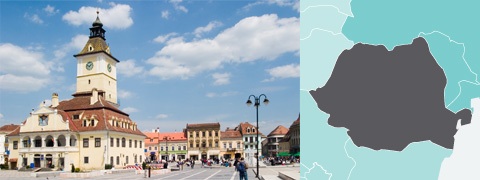Country assessments
Romania
- Details
- Country assessments
2013 sector transition indicators
Source: EBRD.
Note: Water – Water and wastewater; IAOFS – Insurance and other financial services; PE – Private equity.
Highlights
- Romania has exited the European Commission’s Excessive Deficit Procedure. The Commission recognised that Romania had brought its deficit down below the 3 per cent of GDP benchmark under the Maastricht criteria, and had demonstrated strong fiscal resolve since the fiscal slippage induced by the 2008-09 financial crisis.
- Limited progress has been achieved on the privatisation front. While energy sector privatisation has advanced, in parallel with substantial progress on electricity and gas price liberalisation, the flagship sale of the freight railway operator, CFR Marfa, failed and efforts to sell a major chemical company have been unsuccessful.
- Important reforms have been enacted to strengthen financial sector stability. This includes strengthening banking supervision, improving the legal framework for financing micro, small and medium-sized enterprises (MSMEs), and adding additional checks on foreign exchange-denominated lending.
Key priorities for 2014
- The government should accelerate its anti-corruption and judicial reform efforts. The European Commission continues to monitor Romania’s progress on these issues under the Cooperation and Verification Mechanism.
- Further efforts are needed to strengthen predictability for investors in the renewables sector. The postponement in the trading of a number of green certificates may adversely affect further investments in this sector.
- Efforts should be stepped up to the address the high level of non-performing loans (NPLs) in the banking sector. This includes the removal of regulatory barriers to the restructuring or write-off of NPLs, which represent more than 20 per cent of total loans.
Macroeconomic performance
Romania continues to be highly exposed to weaknesses in the Eurozone. A combination of weak external demand, subdued domestic demand and the impact of drought on agriculture led to a significant weakening in economic performance in 2012. As a result, GDP grew by only 0.7 per cent in 2012, down considerably from the previous year, when output rose by 2.2 per cent. In the first half of 2013 economic activity improved. GDP rose by 2.2 per cent year-on-year in the first quarter, due mainly to a strong export performance, and by 1.5 per cent year-on-year in the second quarter. Inflation has come down sharply during 2013, and, having been above the National Bank of Romania’s (the central bank) target band of 2.5 +/- 1 per cent for some time, fell to 1.9 per cent in September 2013.
Fiscal performance has been impressive, given the political pressures faced in 2012. The budget deficit target was revised, from 1.9 per cent to 2.3 per cent of GDP in 2012, in agreement with the International Monetary Fund (IMF), to account for an increase in public wages (which was due to a partial reversal of 2010 wage cuts) and the repayment to pensioners of pension cuts that were later ruled unconstitutional. However, the economic difficulties in the second half of the year took a larger than expected toll on public finances, further disrupting both the pace of fiscal adjustment and the clearance of government arrears. The end-of-year deficit of 2.5 per cent of GDP slightly exceeded the revised target. Furthermore, the government asked for, and received, a three-month extension of the Stand-By Arrangement (SBA), which was due to expire in March 2013, thus gaining more time to meet its targets for reducing payment arrears of the state administration and state-controlled companies. Notwithstanding these slippages, fiscal performance was overall quite impressive, considering that 2012 was an election year, while major expenditure-related overruns were avoided. The government has revised the 2013 budget, raising the deficit target from 2.3 to 2.5 per cent of GDP. Following the successful completion of the previous programme, a new SBA was approved by the IMF in September 2013.
A moderate recovery is taking place this year. GDP is projected to grow by more than 2 per cent in 2013 on the back of a strong export performance and a good agricultural season. Medium-term prospects remain favourable, reflecting the diversified economy and strong catch-up potential in a country where GDP per capita (adjusted for purchasing power standards) is less than half of the European Union (EU) average, according to Eurostat estimates. A more efficient use of EU structural funds would help improve growth prospects.
Major structural reform developments
Some progress has been made in judicial reform and fighting corruption, but further steps are needed. In its latest report under the Cooperation and Verification Mechanism, published in January 2013, the European Commission concluded that the Romanian authorities had implemented several, but not all, previous recommendations regarding the judiciary and the rule of law. The report also noted the steps taken to implement the national anti-corruption strategy, but it also pointed to the very limited progress made on preventing and sanctioning corruption relating to public procurement. The Commission will continue to monitor these issues closely, and will issue its next report at the end of 2013.
Absorption of EU funds remains at a low level. Despite the government’s intensified efforts to increase the pace of absorption, by August 2013 just 21.4 per cent of the approximately €27.4 billion of structural, cohesion and agricultural funds available to Romania had been paid out. For much of the second half of 2012 the absorption of certain funds stalled because of problems in the management and control system, and several operational programmes were pre-suspended. However, some of these programmes have since been unblocked, following remedial action by the government. The Commission has granted a one-year extension of the 2007-13 financial perspective to help Romania minimise the loss of these funds.
Privatisation and restructuring of state-owned companies has advanced haltingly. The state continues to play an important role in the economy, with around 240 companies still owned by the state, and another 700 by local government. The flagship sale of a majority stake in the freight rail company, CFR Marfa, failed. The private railway operator, Grup Feroviar Roman SA, had been selected as the winner of the tender in June 2013, having bid €202 million for a 51 per cent stake and the promise of a further €200 million investment in the company. However, the deal was cancelled because the bidder failed to secure approval from Romania’s antitrust body and did not make the necessary payments in time. More positively, other sales of state shares are ongoing in the gas and electricity sectors, including a successful 10 per cent initial public offering (IPO) of Nuclearelectrica in September 2013, and a 15 per cent IPO of the natural gas producer, Romgaz, in October 2013. Efforts to sell the postal company, Posta Romana, and the large chemical company, Oltchim, have been unsuccessful thus far; the latter has been under insolvency procedure since January 2013, and privatisation efforts will be renewed once it exits this process.
Incentives for renewable investments have been reduced. In June 2013 the government adopted an emergency ordinance under which, from July 2013 to March 2017, out of the total number of green certificates awarded to wind, solar photovoltaic and small hydro projects, the trading of a certain number will be postponed until 2017 (for solar and hydro) and 2018 (for wind). Permission to trade the respective certificates would be from April 2017 (solar, hydro) and January 2018 (wind) until the end of 2020. Certain features remain unclear regarding the non-retroactive character of the provisions of the ordinance, and there is uncertainty about the transparency and predictability of the business environment in which future renewable energy projects are expected to be implemented. The Czech energy group, CEZ, which operates a 600 MW wind farm in Romania – the largest in Europe – filed a complaint with the European Commission regarding the cutting by Romania of its renewable energy support.
The financial performance of water companies has improved. For several years water companies have been undergoing a process of regionalisation, which has led to significant consolidation in the sector and a major reduction in the number of operators – from 260 prior to EU accession in January 2007 to 42 in 2013.
The business environment remains problematic. Romanian businesses continue to face a number of long-standing problems in their day-to-day operations, which are most likely contributing to Romania’s difficulty in recent years in attracting foreign direct investment. The country ranked seventy-third of 189 countries in the World Bank 2014 Doing Business report – the same ranking as in the previous year’s report. As in previous years, the main problems related to getting electricity, dealing with construction permits and paying taxes. In addition, the perception of the effectiveness of the competition authority has substantially worsened in the past year, as reflected in the World Economic Forum’s 2012-13 Competitiveness Report. Progress was made on land reform: from January 2014 foreigners will be permitted to buy land in Romania without having to set up a joint venture with a Romanian firm. Nevertheless, a functioning land market is not yet in place, and farm sizes remain very small on average.
Measures to further strengthen the stability of the financial sector are paying off. Overall, the banking sector has coped well with the effects of the economic downturn in recent years. Banking supervision has been strengthened significantly, and deposit insurance coverage is in line with EU standards. The legal framework for MSME financing has also improved, with the strengthening of the framework for security and collateral over movable property. The National Bank of Romania has continued its efforts to promote lending in local currency. In December 2012 the central bank issued a new regulation on lending in foreign currency, according to which banks must conduct foreign exchange stress tests before extending a loan denominated in foreign currency. At the same time, the level of NPLs is high, at about 21 per cent as of August 2013, however the associated risks are mitigated by high provisioning levels, of close to 90 per cent.













